Manufacturers have easily transformed the AR-15 platform to be compatible with 9mm ammo, and we have tested a few of these carbines back in 2015. Since then, there has been an uptick in new 9mm carbine models, so we decided to take a look at these short semi-autos that share ammo with your pistol. What separates these newer 9mm carbines from some AR-15 carbines is their ability to use handgun magazines. Not only do these carbines share the same ammunition, they also share the same magazine in your pistol. That’s versatility in our book.
The three rifles we procured were the Beretta CX4 Storm, Just Right Carbines’ Takedown Model, and Ruger’s PC Carbine. These carbines offer mild recoil, good accuracy, fast follow-up shots, light weight, and maneuverability. Some, like the Ruger, offer all the bells and whistles and propel the 9mm carbine category from a pipsqueak pistol-caliber carbine to a versatile home defense and survival tool. In the past five or six years, 9mm ammunition has also evolved, and there are a slew of viable loads that make these carbines more versatile than 9mm carbines years ago.
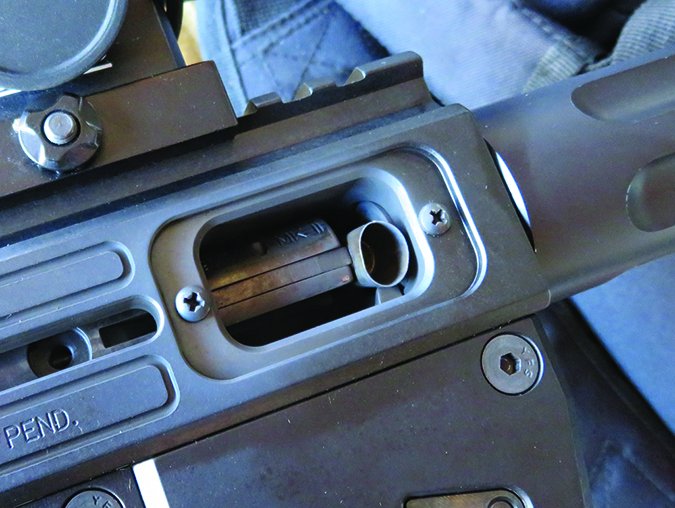
Less recoil means better accuracy and faster follow-up shots, and we all know bullet placement is very important in disabling a bad actor. We’ll take making the first well-placed shot any day. In our opinion, any of these carbines would made a good choice for home defense, for transport in a vehicle, as survival/prepper choice, small game hunting, and an all-round fun plinker. These also make a great transitional gun for shooters graduating from a rimfire round to a centerfire round. All of these carbines also offered an adjustable length of pull so smaller-stature shooters are not at a disadvantage.
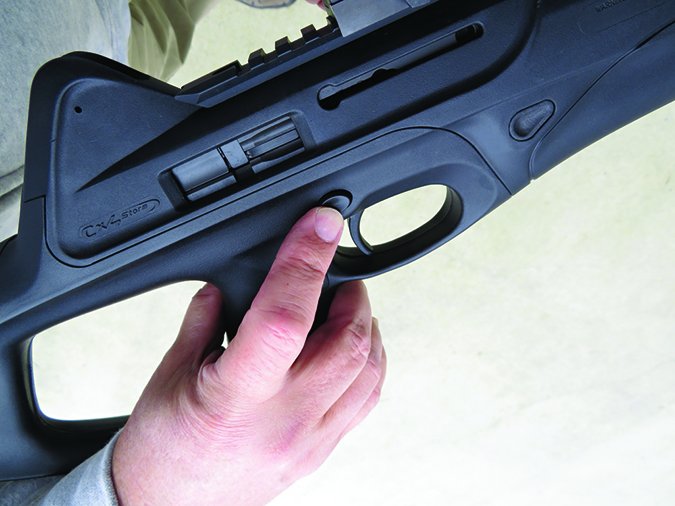
All three of these carbines feed from handgun magazines and use a simple blowback mechanism. You can feel the bolt sliding back and forth in the receiver as the carbine cycles and that adds to the perceived recoil. These carbines are also light and perceived recoil is always higher in a lightweight rifle. In our opinion, the Beretta does the best job of making the mechanism feel smooth, and that’s because the CX4 is more like and oversized pistol than it is a carbine chambered in a pistol caliber. The Ruger and JRC have added flexibility since they are takedown models. Plus the Ruger does a whole lot more. The Ruger PC Carbine is packed with features that actually make the carbine more flexible, adaptable, and useful. Some of our more jaded testers kept going back to the PC Carbine for another try, which says a lot.
9mm Luger Range Data
| SIG Sauer V-Crown 124-gr. JHP | Ruger PC Carbine | Just Right Carbines Takedown Model | Beretta CX4 Storm |
| Average velocity | 1261 fps | 1197 fps | 1195 fps |
| Muzzle energy | 438 ft.-lbs. | 395 ft.-lbs. | 393 ft.-lbs. |
| Smallest group | 0.65 in. | 0.32 in. | 1.62 in. |
| Average group | 0.80 in. | 0.42 in. | 1.65 in. |
| Hornady American Gunner 115-gr. XTP | |||
| Average velocity | 1262 fps | 1230 fps | 1214 fps |
| Muzzle energy | 407 ft.-lbs. | 386 ft.-lbs. | 376 ft.-lbs. |
| Smallest group | 1.05 in. | 0.79 in. | 0.27 in. |
| Average group | 1.10 in. | 0.82 in. | 0.39 in. |
| Streak Visual Ammunition 147-gr. FMJ (tracer) | |||
| Average velocity | 1093 fps | 1135 fps | 1134 fps |
| Muzzle energy | 390 ft.-lbs. | 421 ft.-lbs. | 420 ft.-lbs. |
| Smallest group | 0.99 in. | 0.68 in. | 1.70 in. |
| Average group | 1.46 in. | 0.83 in. | 1.86 in. |
| To collect accuracy data, we fired three-shot groups from a bench using a rest. Distance: 50 yards with optics. We recorded velocities using a ProChrono digital chronograph placed 15 feet from the muzzle. | |||
How We Tested
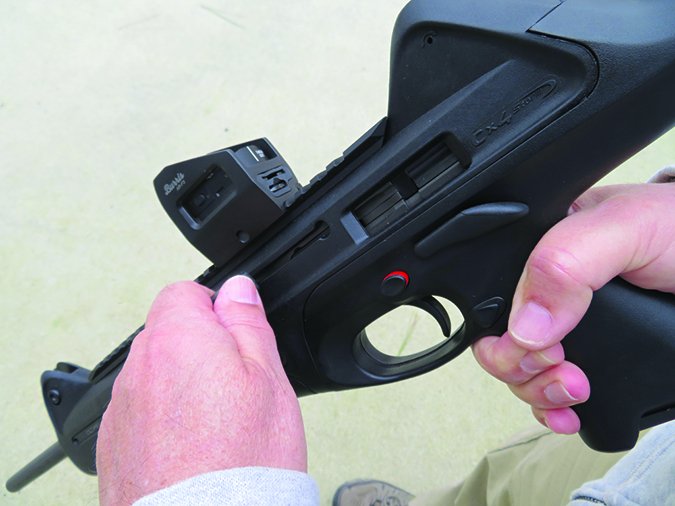
We tested accuracy out to 50 yards with open sights and with optics using our range bag as a rest. Range data was collected with optics. We also tested at 25 yards looking at speed. At 25 yards we loaded and fired two rounds and performed a reload to see how easy it was to manipulate the carbines. Those users familiar with the AR platform adapted to the JRC with little ramp-up time. We also started to see differences in the triggers and ease of magazine manipulations. Ammunition consisted of three different bullets weights in 115-, 124-, and 147-grain weights. The Hornady American Gunner 115-grain XTP hollow points offered phenomenal accuracy in the Beretta, which surprised us. The SIG V-Crown 125-grain JHP ran well and best in the JCR. We also tried 147-grain FMJ rounds by Streak. This is tracer-like ammo without the incendiary effect. Nothing burns, but rather glows. In dim light they were cool to see as they streaked down range. In daylight we could not see the streak. We only had one failure in the test, a stovepipe with the JCR. We could not replicate it. Turns out the JCR needed some lube, which is common in blowback mechanisms. Other than that, these carbines chewed through ammo, and we had a ball testing these guns. Here’s what we determined.
Beretta CX4 Storm JX49220M 9mm Luger, $699
GUN TESTS GRADE: B+
The CX4 Storm offered great accuracy with one load, was light weight, and had excellent balance. The trigger was its weak spot, but we still shot some impressive groups. The magazine-release button could be taller. We liked the peep sights. Overall, it was more difficult to manipulate the CX4 than the other carbines.

| ACTION TYPE | Semi-automatic, blowback |
| OVERALL LENGTH | 29.7 to 31.5 in. |
| OVERALL HEIGHT | 7.25 in. |
| OVERALL HEIGHT (w/ optic) | 8.25 in. |
| WEIGHT UNLOADED | 5.6 lbs. |
| WEIGHT LOADED (15-rd. mag) | 6 lbs. |
| RECEIVER | Aluminum alloy, polymer shell |
| BARREL | 16.6 in. long; 1:10 RH Twist |
| MUZZLE DEVICE | None |
| STOCK | Synthetic, rubber buttpad, adjustable LOP |
| LENGTH OF PULL | 13 to 14 in. |
| MAGAZINE | (1) 15-round |
| FRONT SIGHT | Adjustable protected post |
| BACK SIGHT | Adjustable peep |
| TRIGGER | 6.8 lbs., single stage |
| SAFETY | 2-position crossbolt button |
| WARRANTY | 1 year, +2 years w/ registration |
| TELEPHONE | (800) BERETTA |
| WEBSITE | Beretta.com |
| MADE IN | Italy |
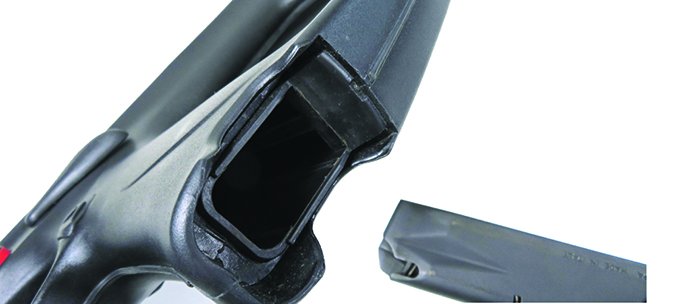
The CX4 Storm was introduced in 2003. This was the most maneuverable carbine in the trio. It acted more like a pistol than a carbine, and that is because the magazine is located in the grip, like a typical pistol, and the weight of the rifle is above the firing hand. With the Ruger and JRC it was in front of the firing hand. In fact, it was easy to shoot the CX4 with one hand. The CX4 was very comfortable to shoot, and that made all the difference because the trigger was mushy and felt like plastic against plastic.
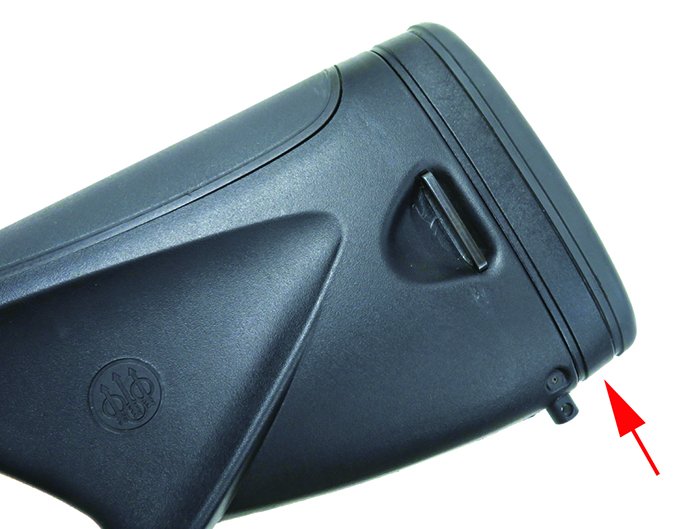
The barreled action is housed in a polymer shell, so the CX4 is lightweight. Most of the controls can be set up for a right- or left-handed shooter, or a combination. The cocking lever, extractor, ejector, magazine release, and safety can all be set up ambidextrously. We set the charging handle on the left side because most users were right handed, and this provides good leverage to rack the bolt. Shells ejected on the right side. The magazine-release button can be switched, too. You can get the CX4 compatible for either Model 92 or Storm pistol magazines. Our model was set up for Model 92 magazines, and the 15-round magazine was flush with the butt of the grip.
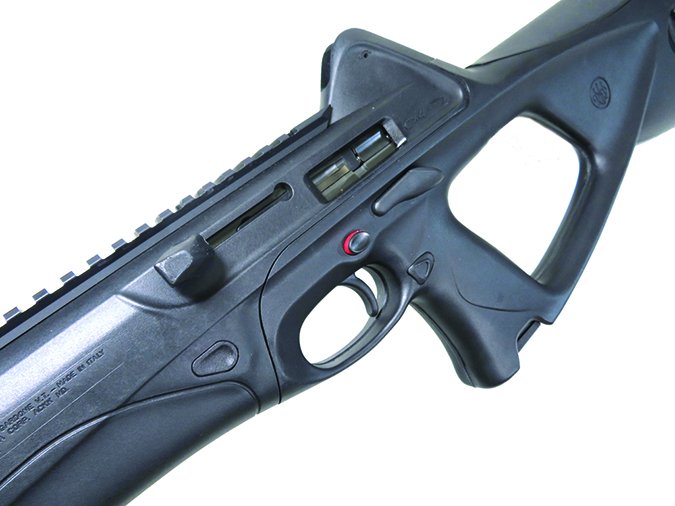
The stock is a thumbhole style and straight, so the fully adjustable sights sit high on the carbine. Polymer wings protect the post front sight and rear peep sight. We thought these were excellent sights. A Picatinny rail on the top side allows the user to mount an optic. We mounted a Burris AR-F3 ($299, MidwayUSA.com) red dot, which is a sight you would mount on an AR. It gives you the correct height to line up with your eye when aiming.
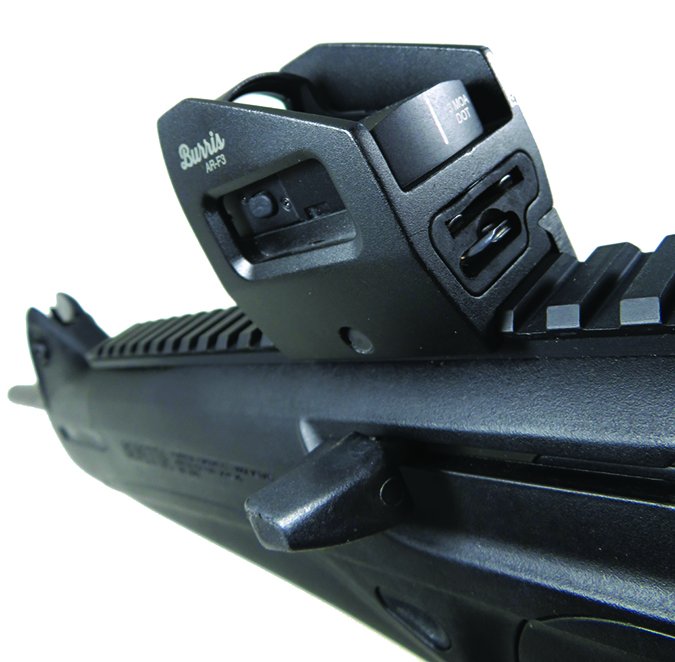
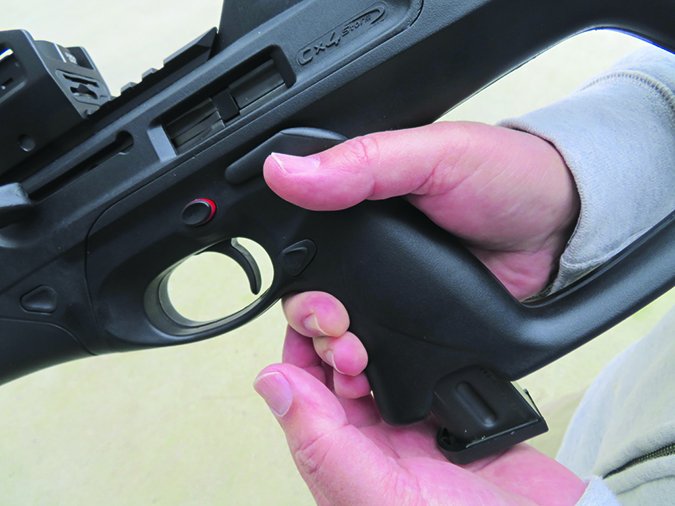
The AR-F3 combines a FastFire 3 red dot with the AR-F3 mount. The mount has wings that protect the red dot and help avoid accidental button manipulation, and the mount can store a wrench and spare battery. The reticle is a 3-MOA red dot. We liked this set up and thought it well suited for the Beretta due to the straight-comb stock. Also, the stock has spacers built in so you can adjust the length of pull by removing the buttplate and adding or removing a spacer. Sling swivels were built into the stock. The CX4 field strips without tools and comes apart easily.
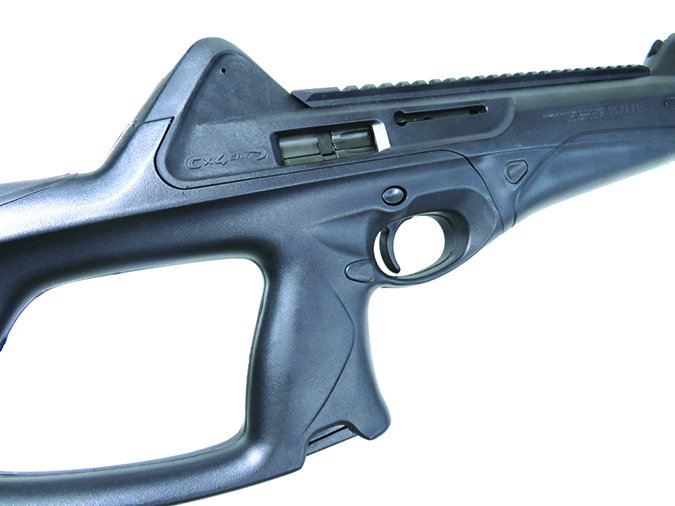
You can buy side and bottom Picatinny rails ($54; BerettaUSA.com) to mount a light or grip, but we felt rails should have come with the gun.

The outside controls were nicely blended into the stock, like the slide release, which was easily operated by the user’s thumb. The Beretta CX4 Storm was sexy looking, but looks can be deceiving. It was slightly more difficult to operate.
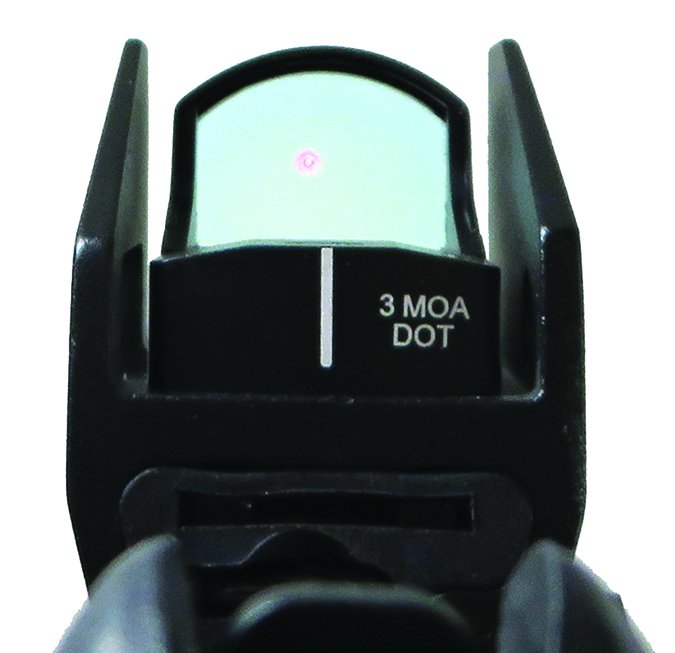
Going hot with open sights, we expected mediocre to okay accuracy and were delighted to find the CX4 was a nail driver. We did shoot some great groups with the Hornady American Gunner 115-grain XTP ammo. Our smallest three-shot group measured 0.39 inch at 50 yards. We had no functional issues with the Beretta.
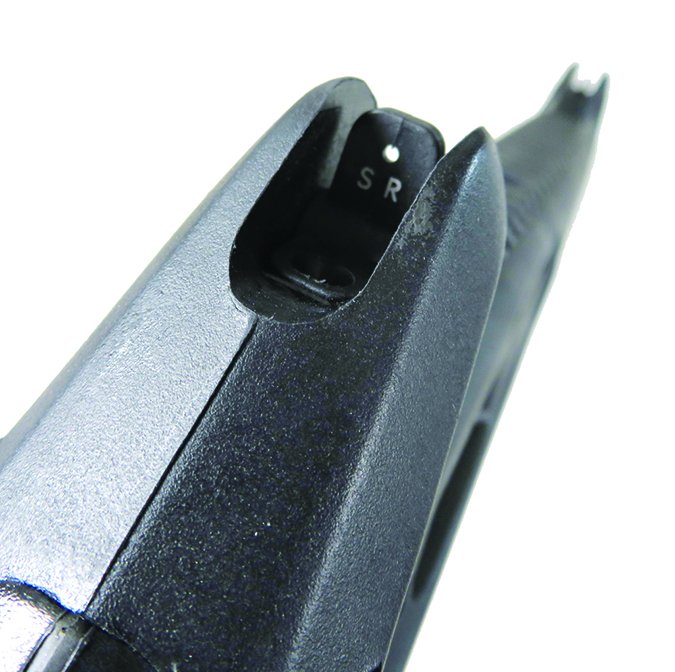
Our Team Said: The CX4 Storm was very adaptable to left- or right-handed users, but it was not as user friendly as the other carbines tested. The controls made it more difficult to operate, though it ran without incident. The cost was also high compared to the other carbines.
Just Right Carbines Gen 3 Takedown Model JRC9MPTDG3TBBL 9mm Luger, $598
GUN TESTS GRADE: A
The JR Carbine offered the best accuracy and more customization because it is compatible with some AR-15 aftermarket parts. It has the ability to be customized for a left- or right-handed shooter. Takedown is simple, but field-stripping is a bit cumbersome.

| ACTION TYPE | Semi-automatic, blowback |
| OVERALL LENGTH | 34.25 to 31 in. |
| OVERALL HEIGHT | 7.5 in. |
| OVERALL HEIGHT (w/ optic) | 9.75 in. |
| WEIGHT UNLOADED | 6.5 lbs. |
| WEIGHT LOADED (15-rd. mag) | 6.9 lbs. |
| RECEIVER | 6061-T6 aluminum alloy |
| BARREL | 17 in. long; 1:16 RH twist, threaded |
| MUZZLE DEVICE | None |
| BUTTSTOCK | 6-position adjustable; M-4 style |
| LENGTH OF PULL | 10.5 to 14.25 in. |
| MAGAZINE | (1) 17-round Glock |
| SIGHTS | None; optics ready |
| TRIGGER | 5.1 lbs., single stage |
| SAFETY | 2-position rotating lever |
| WARRANTY | Implied lifetime |
| TELEPHONE | (585) 396-1551 |
| WEBSITE | JustRightCarbines.com |
| MADE IN | Canandaigua, NY |
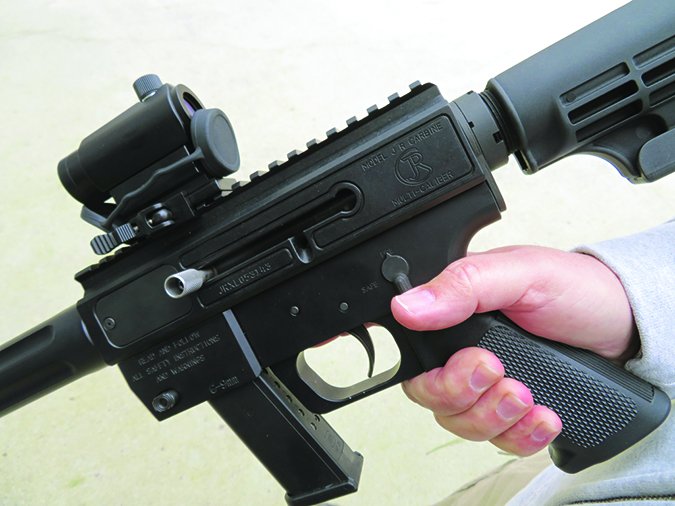
The Just Right Carbine (JRC) offers the AR-15 user fast ramp-up time because the JRC is set up like an AR-15. The safety selector operates just like an AR-15’s. In fact the JRC uses an M4-style adjustable buttstock and receiver extension/buffer tube and AR-15 style pistol grip. This means you can customize the JRC with an aftermarket AR-15 stock and pistol grip. From there, the design is pure JRC, which uses a simple blowback mechanism.

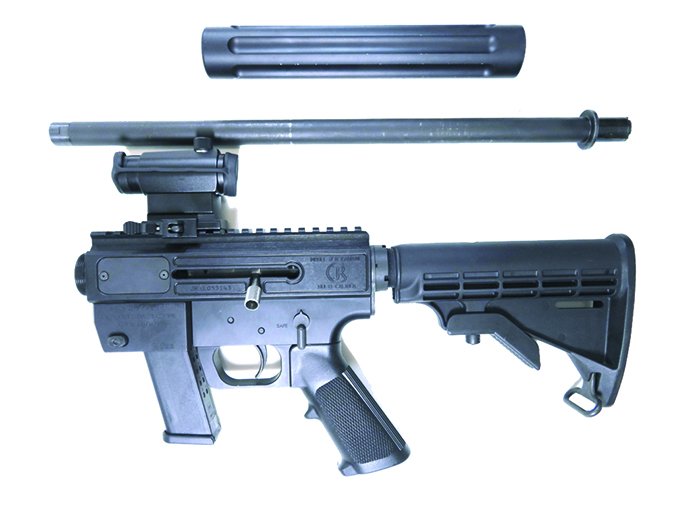
The one-piece receiver is machined and looks similar to an AR-15. The trigger guard is beefy, and the Glock magazine fits in the magwell located in front of the trigger guard. The magazine release is a nice-sized button located at the front left side of the magazine well. The top side of the receiver is a Picatinny rail. This rifle cries out for an optic, so we opted for a Konus Pro Atomic Mini Red Dot ($106; OpticsPlanet.com) with a quick-release riser mount. This optic is designed for use on an AR-15, and it was a great set up for the JRC. It uses a 3.5-moa red-dot reticle and offers 11 reticle brightness settings, which allowed use to fine-tune the dot for low light and bright midday light. We liked this economical red dot and thought it was a good choice for plinking.
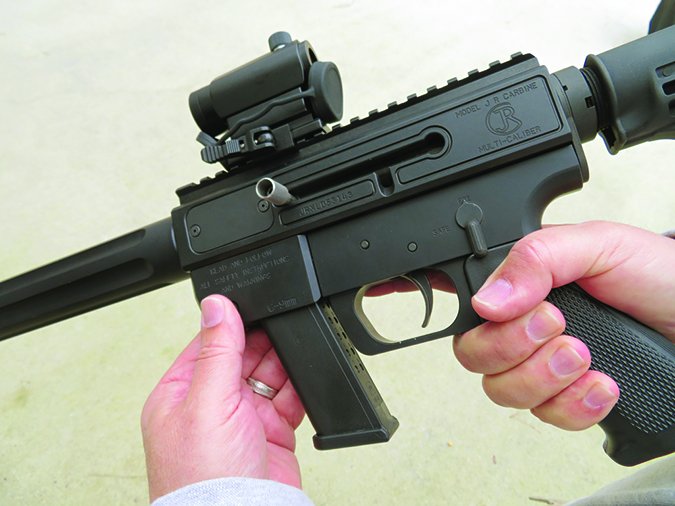
The charging handle can be set up for a right- or left-handed shooter, and the ejection port can also be set up for ambi users. A plate is used to cover the ejection port on the side you do not want the case to eject. You can also have the charging lever on the opposite side of the ejection port. Ours was set up with the charging handle on the left side and eject port on the right. This gave us better leverage when cocking the carbine. An added bonus with the JRC is its ability to change calibers from 9mm, 40 S&W, 10mm, and 45 ACP with a conversion kit ($279 to $319 depending on caliber; justrightcarbines.com). We like this feature. JRC guns are only compatible with Glock magazines, and one comes with the carbine.
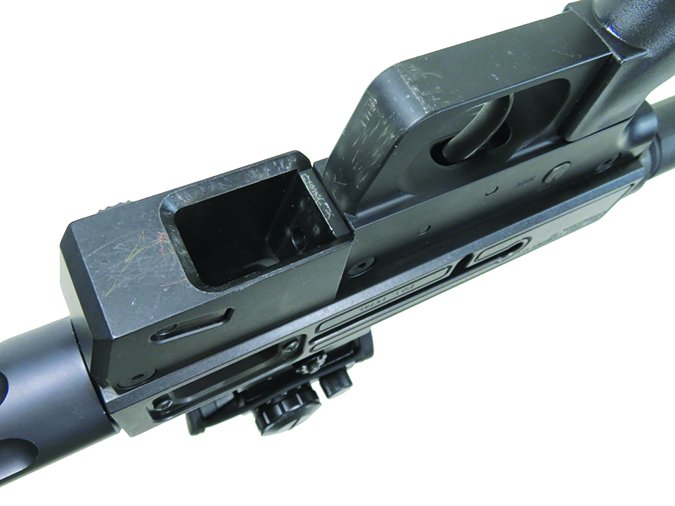
The 17-inch barrel is threaded for a muzzle device and free floated. Our model is a takedown variant. The handguard is a nicely fluted metal tube that allows for enough grip to unscrew the handguard. Just unscrew the handguard and pull the barrel from the receiver. The takedown feature means you can’t use an AR-15 aftermarket handguard, nor can you attach a Picatinny rail for mounting a light, laser, or grip.
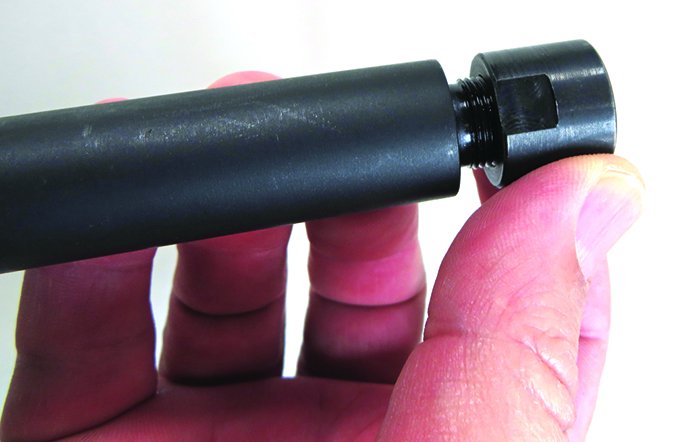
We did have one stovepipe jam with the JRC, and that was after a few hundred rounds. We attributed that to a dirty mechanism. JRC recommends the rifle be cleaned at least every 200 rounds, and we would follow that schedule. The bolt does not stay open on the last shot. We’d prefer the bolt to stay open on the last shot because that allows for faster reloads, and it is obvious the rifle has run dry.
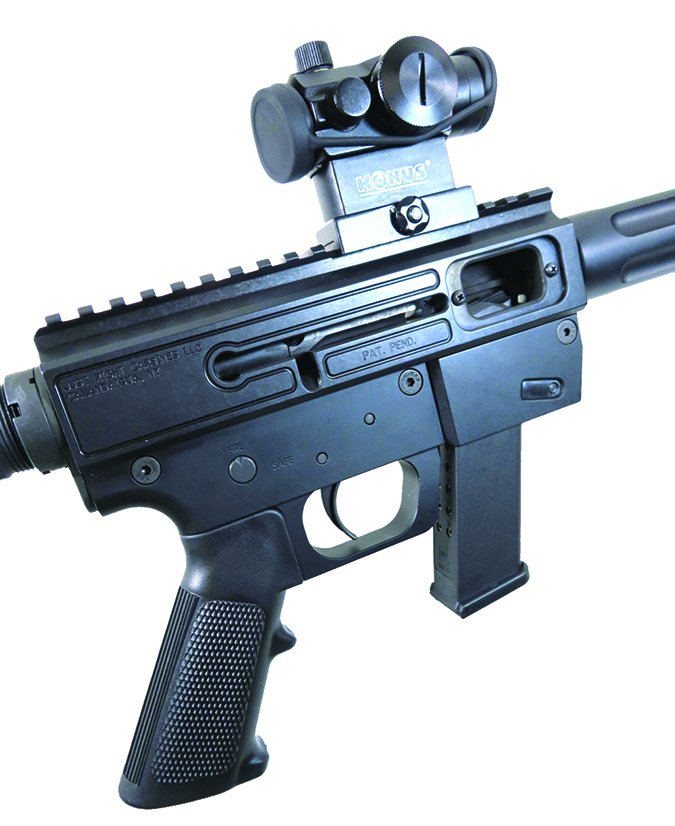
Starting out at 50 yards, we used a rest and found we could consistently fire three-shots groups into clusters that averaged 0.75 inches. In fact, with SIG V-Crown 124-grain jacketed hollow-point bullets, one tester was able to shoot a three-shot group that measured 0.32 inches at 50 yards. Nice.

Our Team Said: The JRC Takedown makes a good choice for a survival rifle or a rifle for your go bag when the SHTF. We like the ability to convert calibers, set up the rifle for left- and right-handed shooters, adjustable LOP, takedown feature, and use of some aftermarket AR-15 parts. Accuracy was stellar. We also like the cost.
Ruger PC Carbine 19100 9mm Luger, $467
GUN TESTS GRADE: A
The PC Carbine is versatile, with modular magazine-well inserts for Ruger and Glock pistols. It is also a takedown, so it’s appropriate for survival or prepper scenarios. Accuracy was okay, and the factory peep sight convinced us a red dot was the best sight choice.

| ACTION TYPE | Semi-Automatic, blowback |
| OVERALL LENGTH | 32 to 34.37 in. |
| OVERALL HEIGHT | 6 in. |
| OVERALL HEIGHT (w/ optic) | 7.25 in. |
| WEIGHT UNLOADED | 6.8 lbs. |
| WEIGHT LOADED (15-rd. mag) | 7.2 lbs. |
| RECEIVER | Aluminum alloy |
| BARREL | 16.12 in. long; 1:10 RH twist, threaded, fluted |
| MUZZLE DEVICE | None |
| STOCK | Synthetic, rubber buttpad, adjustable LOP |
| LENGTH OF PULL | 12.62 to 14.12 in. |
| MAGAZINE | (1) 17-round |
| FRONT SIGHT | Protected blade |
| BACK SIGHT | Adjustable ghost ring |
| TRIGGER | 5.1 lbs., single stage |
| SAFETY | 2-position crossbolt button |
| WARRANTY | None written |
| TELEPHONE | (888) 220-1173 |
| WEBSITE | Ruger.com |
| MADE IN | USA |
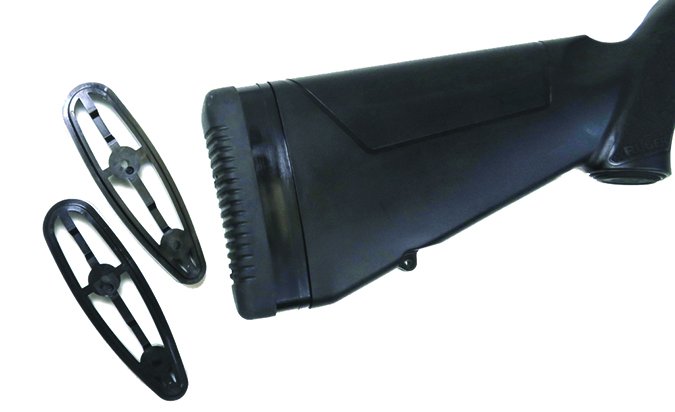
The Ruger PC Carbine — PC stands for “Pistol Caliber” and not “Politically Correct” — could be considered a second generation of Ruger’s PC9 carbine, which was produced from 1999 thru 2006. In our opinion, the PC Carbine we handled here is much better than its predecessor due to the new PC Carbine’s feature set, such as a modular magazine well, takedown ability, adjustable LOP, and sight options.
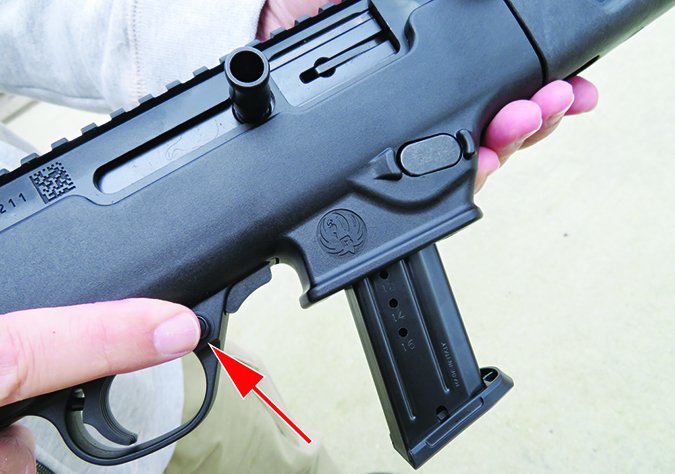
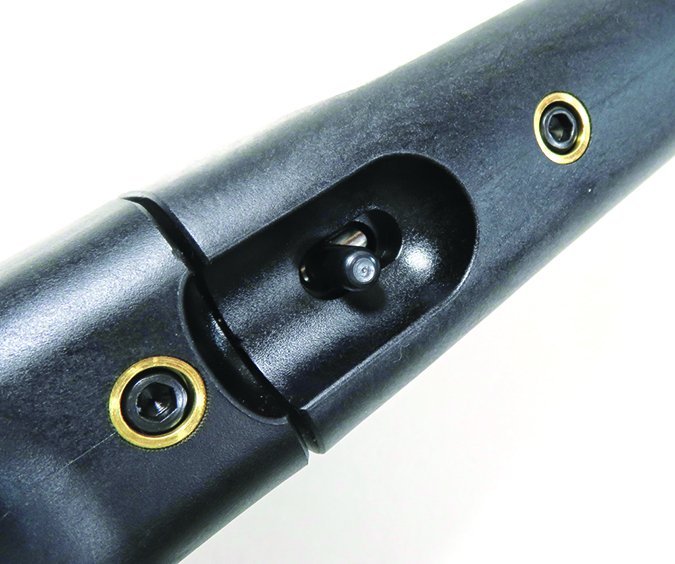
Think of the PC Carbine as a Ruger 10/22 on steroids. It uses a beefier blowback action and features a charging handle that can be switched to the left or right side. We’d swap it to the left side to get that extra leverage when cocking the gun. The magazine release can also be swapped to the left or right side of the rifle. The magazine release on our sample was located on the left side. The aluminum-alloy receiver fits into a traditional-style synthetic rifle stock. The top side of the receiver has a built-in Picatinny rail that’s well suited for a red-dot reflex sight. The 16.12-inch barrel is fluted and threaded and holds the front sight, which is a protected blade. The rear sight is a large adjustable ghost ring. Since this is a takedown rifle, Ruger was smart to keep the sights on the barrel so they don’t lose zero. The trade-off is a short sight radius, which we learned to live with.
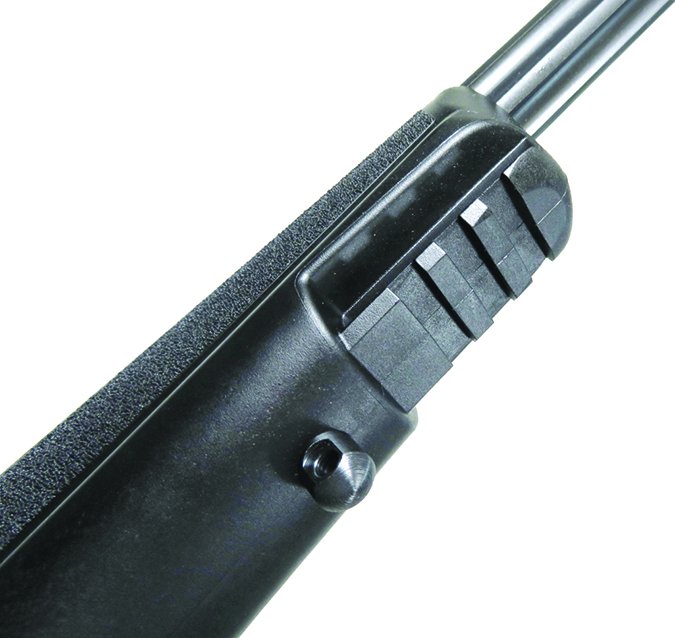
Characteristics that make the PC Carbine stand out include the takedown feature. Press a button under the forend, twist the barrel, and it separates from the receiver, creating a small footprint that is easily packed or stowed. It also makes cleaning the PC Carbine barrel easy. The next feature is the modular magazine well inserts. Disassemble the rifle and the insert pops out of the stock via a press of a button. Depending on the insert, you may also need to do slightly more, but it is that simple. It comes with a magwell insert for SR series and Security-9 series pistols. Ruger American ($29.95; shopRuger.com) and Glock ($29.95; shopRuger.com) inserts are available. Our sample included one SR-Series pistol magazine. We wonder why Ruger hasn’t created an insert for Beretta 92, S&W M&P, and SIG P320 magazines. We think it would be a simple affair.
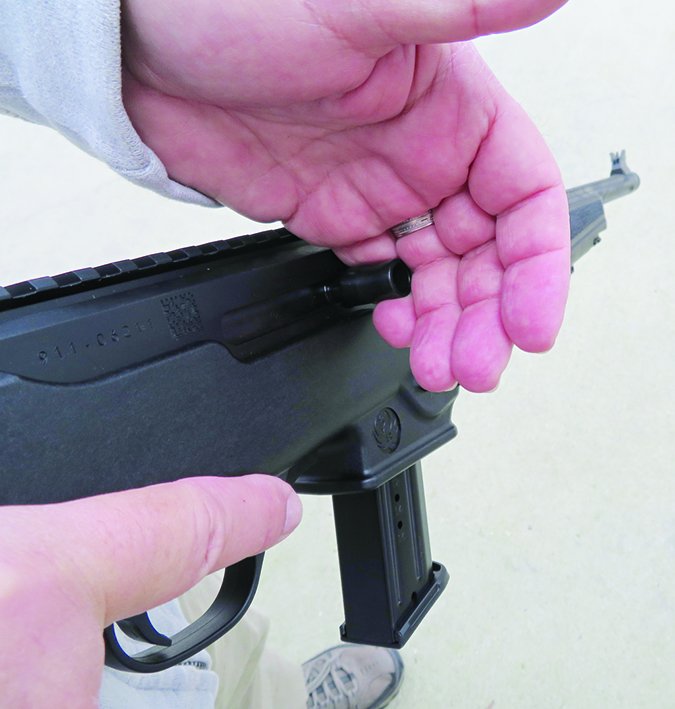
The stock is nicely textured in the gripping areas and uses removable spacers to adjust the LOP. The butt pad is rubber. Hex wrenches for rear-sight adjustment, buttpad-spacer adjustment and charging-handle removal are included in the box. Sling-swivel studs are included, and at the forend tip is a bit of Picatinny rail to mount a laser or light. This, we thought, was a great idea, especially if the rifle is to be used as a home-defense weapon.
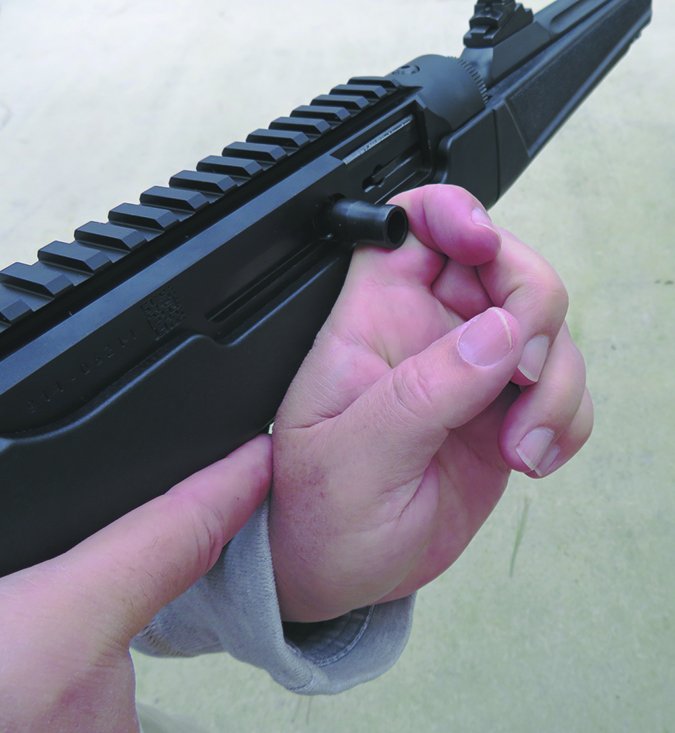
Field-stripping requires tools, which are included, and the process is similar to a 10/22, meaning it is easy. We like how the stock and forend screws are trapped so there is no fear of losing a screw during disassembly. We found online there are a number of aftermarket parts for the PC Carbine such, as extended-magazine-release buttons and a rear sight Picatinny rail mount (taccom3g.com) and trigger-spring kits (mcarbo.com).

We chose a UTG Reflex Micro Dot ($80) with a green 4-moa single dot to mount on the PC Carbine. We used this same sight on a Glock G40 MOS a few issues back and liked the Picatinny rail mount, six brightness settings, and the single-button operation.
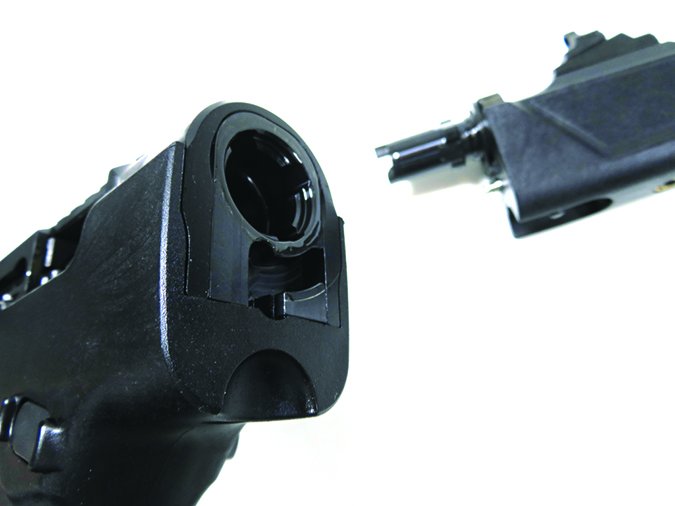
In hand, the PC Carbine is lively and easily aimed. At 50 yards using a rest, we could shoot groups that averaged a little over one inch. At 25 yards during speed testing, the PC Carbine ran well with no malfunctions. The bolt locks back on the last shot. We fired the carbine using the red-dot and iron sights and thought we could live with either. The large ghost ring made target acquisition fast. Shooting with both eyes open allowed us to be fast.The trigger was not as refined as we would like, but it was usable.
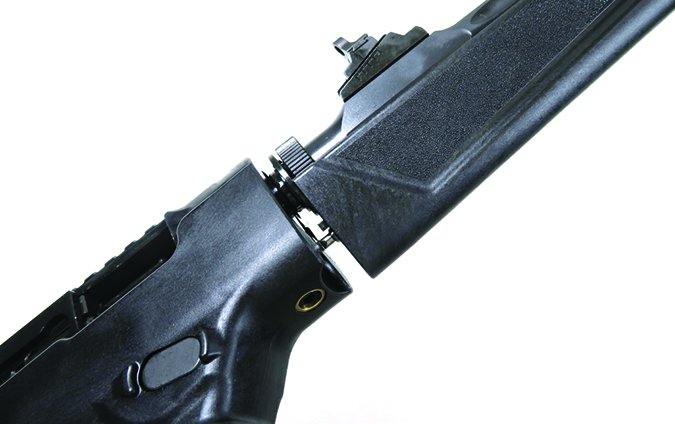
Our Team Said: The PC Carbine is a traditionally style rifle that offers a lot of features for not a lot of coin. It also performs well and offers compatibility with many different pistol magazines and aftermarket parts.
Written and photographed by Robert Sadowski, using evaluations from Gun Tests team testers.
Special thanks to Eastern Outfitters of Hampstead, NC, for their assistance.


























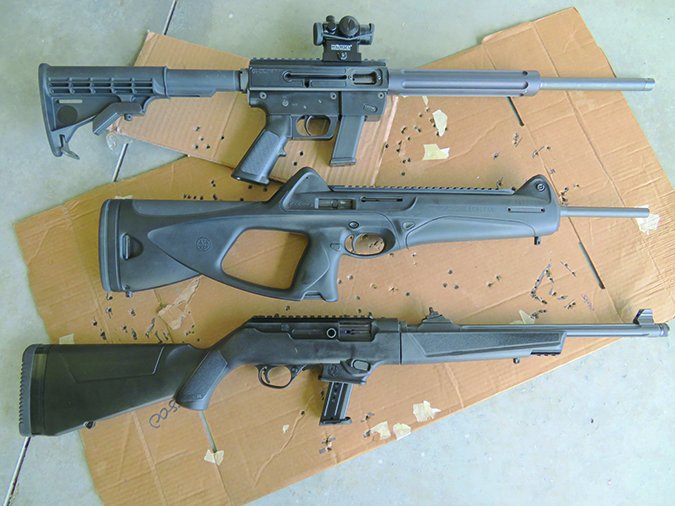




Never understood the excitement about the PC Carbine. Reminds me of an old Remington Nylon 66 from the 60s, but not as good looking and twice as heavy. Sure it breaks down, but the 20″ length is still too long for a standard briefcase. Ruger should have just copied/refined the Kel-Tec Sub-2000 Gen 2, much as they copied/refined the P3AT. The sub-2000 is an outstanding piece of engineering, but the implementation falls short in some areas that Ruger might be motivated to address. I love my Sub-2000 (after upgrades) but I realize that some people have a bias against Kel-Tec products.
The ruger PC Carbine I shot is a tack driver, with a 1-4 power variable scope, I was able to shoot rough one hole groups at 20 yards, with every ammo I put through it. It is not cheaply built, and simply handles well.